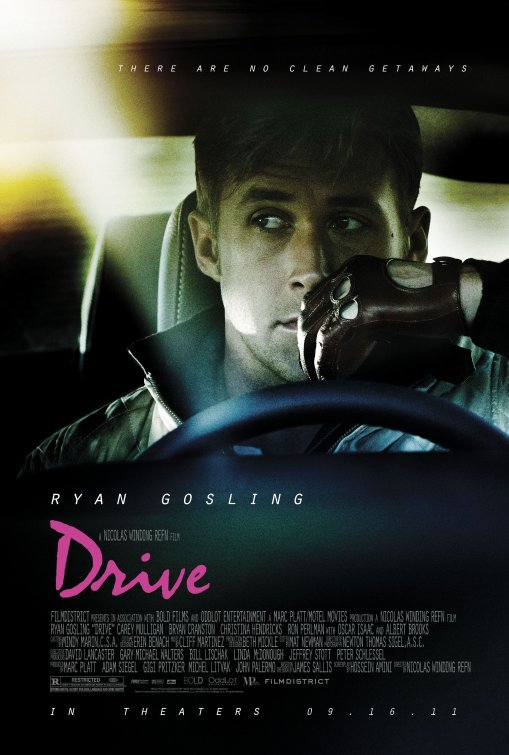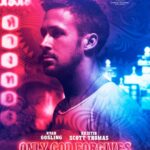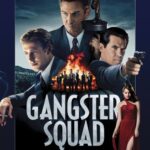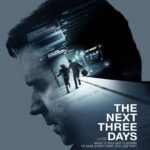There Are No Clean Getaways
Director
Nicolas Winding Refn
Starring
Ryan Gosling
Carey Mulligan
Bryan Cranston
Albert Brooks
Ron Perlman
Drive is very much a film of moments rather than narrative progression, so this plot description is going to seem very underwhelming. The nameless lead character [Gosling] is an expertly skilled driver who juggles three jobs as a mechanic, a movie stunt driver and wheelman for criminals. All three he executes with precision and ease but, most notably, an eerie unwavering calm. Outside of work, his life is incredibly Spartan but he appears happy to exist that way. After running into a neighbour in a local market, the driver dutifully carries her shopping. Once inside her home, we learn that Irene [Mulligan] has a young son, Benicio, whose father is currently serving out a sentence in prison. Over time, a very innocent romance builds between the two and Benicio instantly takes to the quiet, confident, tooth-pick biting gentleman. Running parallel to this is the more seedy actions of LA gangsters Bernie [Brooks] and Nino [Perlman] and their proposed partnership, sponsoring the unnamed lead as an official race-car driver. Once Standard (Irene’s husband played by Oscar Isaac) is released from prison, the driver instantly recognises that he can no longer continue seeing Irene and her son. The initial testosterone sparks between the two men feels like it will play a central plot thread but this quickly dissolves when the driver offers his services after Standard’s prison debts catch up with him. Soon, the central thread shifts from an awkward friendship to a white-knuckled vengeance list.
As far as praise goes, two individuals instantly take centre stage. First of all, Nicolas Winding Refn is an incredibly very primal director, whose previous films focus on man’s most carnal driving forces. In this instance, filming an adaptation of a novel, he has essentially been grounded by a plot (bolstering his trademark editing and flow) but retains his keen photographic eye and gorgeously executed shots. However, this is as much Gosling’s film as it is Refn’s – once cast, it was actually Gosling who sought out Refn and drove him around Los Angeles to get a feel for the city. Additionally, Gosling has come a long way over the years, much like Joseph Gordon-Levitt sticking with more independent films with greater stories and character portrayal. Throughout this hypnotic slow-burning film, his magnetism and charismatic calm completely carry the story from scene-to-scene, ranging from a very sweet, innocent romance to the most brutal and excruciating acts of sheer will power. To pen a review for this film and not make a Travis Bickle comparison is just too difficult, Gosling has proven himself very much a De Niro for this generation.
The whole thing is incredibly surreal and mythic, not to mention a complete nostalgic throwback to the early works of Scorsese, De Palma and Coppola with its generous pacing, anti-heroic (or arguably completely heroic) central character and abrasive violence. Another obvious contemporary comparison, so far as structure, plot and character development are concerned, would be the latest offerings from David Cronenberg, specifically A History Of Violence – with its slow building pace and achingly long stares interspersed by moments of brief shockingly graphic violent eruptions. From a technical standpoint, Drive is a marvel, utilising colourful, soft hues rarely seen in Los Angeles with clear, crisp imagery and inspired framing. Each scene is lit, arranged and moved through with a grace and beauty often found in independent art-house releases, while still conforming to mainstream expectations – kind of like a colourful version of The Machinist. Aside from the visuals, the audio production plays an intrinsically key role in audience immersion, with an inspired score and soundtrack, perfectly fitting volume and mixing levels and novel use of interior and exterior muffling – not only depending on camera placement but also to emphasise rising tension.
Of course, it’s not a perfect release and as developed as the supporting characters are (aided by exceptional casting decisions) the supports still fall in line with the expected framework and never really deviate too far. There’s also the question of the severe levels of violence, which are not only few and far between but also rather tame by contemporary standards. The thing that makes them agonising to watch has little to do with the blood and more the reactions and phenomenal foley contributions. All-in-all this is a very bold piece of work that harks back to a time when independent filmmakers made truly edgy and uniquely entertaining movies, the only problem (and it was the same forty years ago) is that the violent nature of the film usually cripples the release; which is a shame because this is a surprisingly beautiful body of work from all involved.
Release Date:
23rd September 2011
The Scene To Look Out For:
For a film of standout moments, it’s quite tricky to pin point one in particular without either divulging too many plot points or simply under-selling the effect. I think the most memorable scene is probably the first. Coolly and calmly, the driver explains what he is willing to do and then, flawlessly and without panic, executes it. From there, we are treated to a very stylised synth-heavy track and one of the nastiest fonts in bright neon pink. It sounds atrocious but the effect immediately sets the tone and is absolutely stunning.
Notable Characters:
As stated previously, Gosling gives a thoroughly commanding performance, channelling confidence, commitment, determination and dri… er… focus. Sorry, not a fan of puns or title referencing. Outside of Gosling’s efforts, I was incredibly surprised by Brooks’ presence (haven’t seen much of him recently) and role; deviating from his comedy comfort zone, Brooks genuinely comes off as a ruthless businessman but, when needs be, a cold-hearted killer.
Highlighted Quote:
“I know a lot of guys who mess around with married women, but you’re the only one I know who robs a place to pay back the husband”
In A Few Words:
“A stunning little release proving that Refn is capable of more mainstream flicks (not that he needed to prove anything) and that Gosling is fast becoming a legend of the independent circuit”
Total Score: 4/5
![The Red Right Hand Movie Reviews [Matthew Stogdon]](https://reviews.theredrighthand.co.uk/wp-content/uploads/2021/12/cropped-header1.png)




